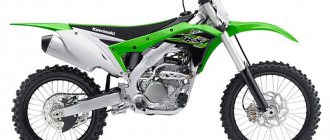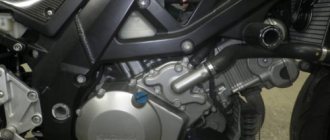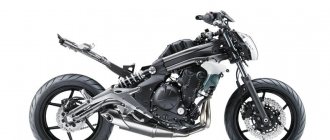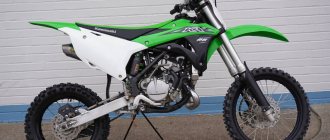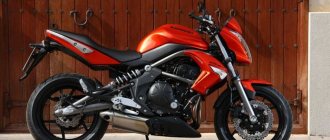The Suzuki RM 250 cross-country motorcycle was presented to the general public in the distant 1976. 5 years later, in the early 1980s, the bike received a modern appearance. This was the only change to the motorcycle in its entire history. Production continued until 2008, but already in 2004 the developer releases an updated version - Suzuki RM-Z250.
Despite its rather respectable age and 2T (two-stroke) engine, the bike had serious advantages - a simple suspension, but with all the adjustment capabilities , a 5-speed transmission and less than 100 kg of dry weight .
Initially it was planned only for North American countries, but seeing the interest of users in 1989, deliveries began around the world.
It was not officially offered to Russia, but was available through “gray” sales. Since the model is no longer produced, the motorcycle can only be purchased on the secondary market.
Question: IS THE RM-Z250 UPDATED FOR 2020?
A: Yes, but only if you take into account the change in color combination on the tank's graphics. But let's not forget the list of changes that were made to the 2019 RM-Z250. Last year, the RM-Z250 received an updated frame, Kayaba forks, a larger front rotor, dual injectors, a new shock absorber, an updated cylinder head and new plastics. All these upgrades make the bike much better, with the exception of the stiffer forks.
Changes to the 2019 RM-Z250 bring power up from a low 6,700 rpm to finish the process. This made 2 horsepower higher in the rev range. This is exactly what the RM-Z250 needs. It has always offered good power in the low and mid range, but until 2022 it was strongest at the top end. Engine updates for 2022 take the RM-Z250's powerband to a higher level.
Brief history of the model
2002 - launch of the Suzuki RM-Z 250. During this period, the model is an exact copy of the Kawasaki KX 250 F.
2003 - 2009 - the motorcycle remained virtually unchanged technically. Only the ergonomics and precision of motorcycle control changed.
2010 - Suzuki seriously updates its Suzuki RM-Z 250. It is a completely new motorcycle with fuel injection and a redesigned chassis. Almost every component of the motorcycle has undergone changes - this includes a new aluminum frame, more advanced cooling radiators, and new adjustable suspensions. In addition, the Suzuki RM-Z 250 no longer had a battery, and the 16-bit engine control unit was powered by an internal capacitor.
2011 - The motorcycle oil pump was moved to the bottom of the crankcase, changes to the engine affected the cylinder shape and camshaft profile. Thanks to changes in the engine, the motorcycle began to produce power characteristics at the level of market leaders.
Q: HOW DOES THE RM-Z250 PET UP AGAINST THE COMPETITION?
A: Every bike in the 250 four-stroke class offers a clean, practical and reliable package. Unfortunately for the 2020 RM-Z250, it's not very popular among serious racers. It offers the lowest peak power in its class by about 3 horsepower. A good exhaust system can bring the RM-Z250 up to the peak power of the only other mid-size engine in the 2020 class, the Yamaha YZ250F, but you'd be pegging $1,000 on the base price. The problem with this strategy is that you'll have to pay extra to push the RM-Z250 to competitive levels, which only results in parity with the competition unless the competition adds its own aftermarket. In a sense, making a slow bike faster is like a cat chasing its tail; it may come close, but ultimately there is no satisfaction.
The Suzuki 2022 is one of the easiest to ride low to mid range bikes. It's at its strongest below 8,000 rpm, and there's no benefit if it revs past its 11,600-8,000-rpm peak. Power is instantaneous at low revs, but relatively smooth beyond 14,000 rpm. Its laid-back nature makes it ideal for young riders who aren't ready for the fire-breathing, 250 RPM rev ranges of the 2020 KTM 250SXF, Husqvarna FC250, Honda CRF250 and Kawasaki KX250, to make the 2020 RM-Z250 equal to the class-leading amateur race engine class or 250 cc engine. A CM like the KTM 250SXF would need $4000 for porting, pipe, piston, cam and ignition.
The 2020 Suzuki RM-Z250 has an attractive base price of $7,899. The best advice is to ride it as is, enjoy its ease of use, and don't chase your tail for $9,099 wonder bikes.
Q: HOW GOOD ARE THE KAYABA COIL SPRINGS?
A: What we really wanted to ask was, “How bad are the Kayaba coil spring forks?” They are not good; they are terrible. We don't understand Suzuki's logic in making forks that are supercross stiff. This is the fourth time in the last seven years that Suzuki engineers have made this mistake. The 2014 RM-Z450 and 2017 RM-Z450 forks were stiff enough for Weston Pake to race supercross. The 2022 and 250 RM-Z2019 forks feature 5.0 N/mm springs. This is the same spring that Honda, Yamaha, Suzuki and Kawasaki are working on their 450 forks. In contrast, the Kayaba coil spring forks on the 2020 YZ250F have 4.7 N/mm springs. Take our word for it, the 2020 Suzuki RM-Z250 forks are too stiff for the typical 250 rider—whether beginner, intermediate, or pro.
Looking at the half-full glass, Kayaba's RM-Z250 units are exceptional components (as evidenced by how well they work with other brands). Internally, they have the same capabilities as other forks in the class with softer springs. Changing the spring norms is the least you can do to get back into the stadium.
The 2020 Suzuki RM-Z250's engine has good mid-range to mid-range power, but it lacks the top-end Pizazz.
Modifications and competitors
Honda CR250R.
Kawasaki KX 250.
Yamaha YZ 250.
With the same steel frame, the bike has only one competitor - the Kawasaki KX 250.
Other manufacturers of the Japanese four made equivalent motocross versions based on aluminum frames.
- For Honda it's the CR250R.
- For Yamaha - YZ 250.
Q: Is the RM-Z250 still an all-expenses chassis?
A: When the chassis was updated for 2022, Suzuki placed even more emphasis on the front end. We hate it when engineers mess with a good thing. The problem with Suzuki's new frame geometry is that it never stood a chance of success. Overly stiff forks were detrimental to expected cornering. Unable to cut into the apex of the corner or absorb the bumps on the way into the corner, the forks destroyed the frame. every MXA
test rider was chasing a balanced setup on the RM-Z chassis, but this required moving the fork in the triple clamps to get more weight at the front end, which resulted in us dropping rear sag to 107mm to keep the chassis level . At this lower setting the bike carves like a knife, but on fast and rough straights it becomes wobbly. This is the price you pay for suspension engineers' mistakes.
Auxiliary hole button. Cards are exchanged in three connected pairs.
2005 model year
21.10.2005
Suzuki never ceases to amaze! The bike's strongest feature is its combination of stability and outstanding cornering performance. This bike can easily be ridden at very low engine speeds to improve traction control without having to worry about stalling. In addition, the bike readily performs jumps.
There is a saying: better late than never. But we will say it differently: it’s better to take a closer look at the one who comes last, because he has already seen his competitors. This is exactly what Honda did in relation to the Yamaha brand in the battle for the MX class four-stroke motorcycle segment.
And now Suzuki wants to beat all other competitors, including Honda cars. A year ago, Suzuki made a bold move by announcing that it was starting to produce SUVs, and this market segment has always had the highest competition. The RM-Z was supposed to compete with the CRF450R, which reigned supreme in the class, if not all of motocross. Think about how long it takes to develop a bike, and Suzuki had to rush to get the new bike ready for the 2005 model year.
Prototypes of the new car quickly began to appear on testing grounds and participate in international races. And just as quickly as they appeared, they began to change, demonstrating Suzuki's rapid testing process. Already at the end of autumn, a photograph of the planned “serial” version of the RM-Z450 model appeared. However, we have seen Suzuki test riders turning up with a slightly modified bike. Around the same time, testing began on the 2005 Honda CRF450R, and word began to spread like wildfire about how much better the machine had become. That's why we called our test ride of the Honda bike "Moving Target" (November 2004).
Continuing to intensively test the bike, Suzuki engineers began to appear more and more often, so rumors spread that the motorcycle would change even more. The company has repeatedly announced the date for the presentation of the new motorcycle, but has constantly postponed it for “several weeks.” When we started preparing our comparative test ride of four-stroke motorcycles in the 450cc class. cm 2005 model year, we were afraid that Suzuki would delay the release of its car until 2006.
At this time, we received a press release stating that “The first RM-Z motorcycles are rolling off the assembly line!” Struggle for existence? Suzuki dealers told us that people who paid a deposit took the money and went to Honda dealers. Since the motorcycle's presentation to journalists had not yet taken place, we were perplexed: “They want the RM-Z model to appear in dealers before journalists can test it? If so, does that mean Honda is better?” Meanwhile, Suzuki Racing continues to race the factory RM-Z, even though the bike may qualify for a production model, as the unreleased KTM SX 250 four-stroke did.
If there was ever a storm cloud over any bike, it was the RM-Z450 - it rained for so long that when we got the new bike, it was the first sunny day in Southern California in weeks, and every free day the track was flooded! As you no doubt already know from our first impressions piece, the bike blew us away from the start. But sometimes it takes time to think things through. The RM-Z has been on the track almost non-stop since it arrived, and we still ride the bike today - this time testing it side-by-side with the CRF machine.
At first, you need to hit the starter very hard to get the Suzuki motorcycle moving. It appears that the motor starts working through a high ratio and requires a certain amount of force to achieve the full stroke of the piston. But a good hit starts the engine right away. In addition, the engine has an excellent, rich sound, and when you open the gas, you feel a clearly defined increase in traction. You immediately realize that this Suzuki machine is a much more traditional four-stroke motorcycle compared to other large-bore engines.
This bike has serious power from the stroke and plenty of torque from low revs. And the engine gently increases traction. You feel powerful energy rather than vibrations from increasing engine speeds, and you can confidently exit corners at very low revs. The power builds up so smoothly that there is not a single sharp surge in all distribution ranges.
It takes a while to get to the very end of the range, which is why the Model Z has such tremendous four-stroke appeal. The bike does not lose traction even on the most slippery surfaces. The RM-Z's power distribution suits the four-speed transmission well. Given that first gear is low enough for the tightest corners, you don't have to shift often. At the start and in most turns, second gear is used.
Third gear is used for many corners and on most straights, and fourth gear can be used when there is no one in front of you on the track. We rode this bike on the high-speed Grand Prix circuit and found that the fourth gear ratio is large enough to achieve the highest speeds that would be difficult to achieve on a motocross track - even with stock gears.
Excellent power forces many corners to be taken in higher gears, and the excellent clutch performance helps here. You have excellent feel and control of the grip, and this allows you to fly out of corners with ease. We did this quite often, and the clutch handled such loads without much difficulty, although not without some squealing. The engine barely stalled unless the idle speed was really low, but even then the bike usually started right up.
But if you crash, you may need to use the hot start button and you will lose time since the car still uses a carburetor. First of all, we would buy a hot start lever and install it on the steering wheel. The cool thing about the RM-Z is that it has exactly the kind of four-stroke power that we thought Suzuki couldn't achieve. We expected the power distribution to be more rev-dependent and more aggressive, but the RM-Z wasn't like that.
The bike may seem like it has unlimited power, but sometimes this distribution can be very deceiving. Everything happens quickly! The power is soft to a certain extent, but it's certainly impressive, and on the track this bike is one of the best handling four-strokes around.
Moving on to the chassis and handling, the RM-Z continues to impress. We were wrong to think that this bike would be built in the Suzuki spirit, would be the benchmark for a lightweight bike, and would probably ride with some jerkiness. We weighed the Suzuki (without gas) and it was relatively light at 233 pounds, but we wouldn't say the bike was feather-light on the track.
You feel that the motorcycle rides stably and, combined with the high power, you feel the weight of the machine. But the RM-Z's weight is consistent, and the bike doesn't feel heavier as the engine revs increase. Good balance seems to be determined by the placement of the crankshaft. Another amazing feature of the RM-Z is its stability. When we tested the wet, lumpy Racetown 395, the bike didn't even have any front-end shake.
On our Grand Prix circuit, this could happen all the time on fast and lumpy straights, but the front end behaved calmly. We noticed the same thing on the I-5 MX track. Making turns impressed us even more; This feature impressed us more than the stability. We've always liked the effortless feel of RM models, but with the quieter four-stroke engine the bike turns even better.
This model arguably corners better than any other motorcycle available today. The bike isn't as light as a two-stroke RM, but on the other hand, there aren't many bikes that are as stable and as controlled in corners. The front end is very confident on the ground, and the bike responds well to the handlebars. In addition, potholes have little to no impact on the bike. What helps here is the larger 90/100-21 Bridgestone front tire, which has more contact surface area than skinny tires. The slight increase in weight is more than compensated for by the additional grip on the surface. Both the front and rear tires provided exceptional performance and demonstrated amazing durability.
With the RM-Z, suspension adjustments are extremely important; The suspension height is of particular importance. That wonderful handling we just talked about can quickly disappear if you turn up the compression damping adjustment just a few clicks or set the sag too low (104mm is the recommended setting).
Another important adjustment is fork height. The top edge of the fork tube should extend 3mm above the skid plate, lowering the bike at the front. During testing, Suzuki found this adjustment to be ideal, and most of our test drivers agreed.
Overall, the Showa suspension works great, providing a soft and controlled ride. On soft surfaces the suspension performs fantastically. The suspension is quite rigid, so it doesn’t go to the extreme position. The initial move is adequate and not very sharp. On harder surfaces, the initial travel is felt more strongly by the driver, and you can feel the suspension respond a little more sharply. The shock absorber has a tendency to use suspension travel quickly.
In this case, increasing the high speed compression adjustment helps. Whenever the bike started to wander or felt stiff, we noted that the rear end was too low. The best solution was to check the sag or increase the compression rate so the bike would ride higher during suspension travel. An alternative option was to adjust the rebound force, but this solution was not as effective. Our ideal adjustments for 180 lb (81.5 kg) riders were: 4 to 8 clicks of stock compression damping adjustment, 2 to 2 1/8 clicks at high speed, and rebound damping adjustment always around 9. No fork adjustments had an equally significant impact on the car's performance, so we set the compression damping to 7 and the rebound damping to 9.
If you haven't figured it out yet, let's just say that we really liked this bike! So why was the release of such a good motorcycle delayed? Obviously, this was due to production problems and the desire to produce a reliable motorcycle that meets certain standards. Most of the parts were released several months ago and were lying in a warehouse, awaiting the end of production of the remaining components.
Given that the plant produces so many important models such as the GSXR, it becomes difficult to load the assembly line with an SUV, even one as serious as the Suzuki RM-Z. Then you need to ensure a sufficient number of spare parts in dealer warehouses within a short period of time after delivery of the motorcycle. The bike will definitely still be checked for defects since its release was delayed, but we don't think such an inspection will reveal any flaws. The RM-Z is so good that we are now testing it against the CRF to see how it compares.
Do you think that the new RM-Z motorcycle will not reach this level? Some will say that it is no more possible to compete with CRF than it is possible to build the best motocross bike in just a year.
Opinions
I love four-stroke motocross bikes, and I think the Suzuki RM-Z450 might be one of my all-time favorites. It is impossible not to note the high dosed power, which is already present after idle mode. This bike can easily be ridden at very low engine speeds to improve traction control without having to worry about stalling. Even at very low revs the power is very strong, but the bike tends to sit on the rear wheel rather than spin it. The bike's strongest feature is its combination of stability and outstanding cornering performance. The same can be said about the adjustable steering wheel. In addition, the bike readily performs jumps.
Suzuki made the suspension on their 2005 model year motorcycles very soft, but now that test riders have been able to put more miles on the machines, they are trying to adjust the suspension travel to my weight. The RM-Z model is no exception. I think drivers over 185 lbs (84 kg) will have to work with the adjustments, but the RM-Z is worth it.
Karel Kramer, 185 cm, 92.5 kg / beginner motocross rider
I was initially skeptical about the RM-Z, as Suzuki is releasing its first SUV with an aluminum frame. I remembered the 1997 CR250, which I considered the worst handling motorcycle. Honda is now on its fourth generation frame, and finally, after much trial and error, the aluminum frame started to work. Knowing how long it took, I was extremely surprised that the RM-Z handled so well. After three days of fine-tuning the suspension (I ended up getting a little help from Karel), the RM-Z felt amazing. The suspension adjustments turned out to be especially sensitive; One-click adjustment to plus or minus played a big role. Another thing that was very impressive was the front brake. The bike seemed to stop better due to the larger front tire. In fact, I have nothing bad to say about the RM-Z. I only have one question left: What about reliability and durability?
Tod Sciacqua, 172.5 cm, 77 kg / experienced professional
As you already understand, I was very skeptical about this bike. This impression arose especially often when I looked from the outside and compared what was happening with what I had seen before. But how wrong I was! Now I have to admit my mistake, but I don't regret it. Because I really liked this bike, even though I had a lot of different reasons to hate the RM-Z. I know that most RM machines are aggressive motorcycles that require a lot of attention from the rider, never allowing you to relax in the saddle. The RM-Z 450 is the exact opposite of all this. From the engine to the chassis, the RM is one of the easiest motorcycles to ride and ride fast. I can ride this bike significantly longer and not feel tired. I didn't even have to switch often. I very rarely used the clutch. No matter where you want to turn, the bike can handle it. Grip in the slipperiest areas allows for safer jumping. The only thing I didn't like was when the suspension didn't work, but you quickly realize that something is wrong with the car and you fix it.
Jimmy Lewis, 178 cm, 85.5 kg / experienced professional
Advantages
• The fact that Honda was the pioneer of the aluminum frame configuration of SUVs allowed us to avoid mistakes. • Suzuki has managed to create a four-stroke bike with a more traditional power distribution that is also very fast. • The RM-Z's power output is more suited to a four-speed than any other four-speed car. • Creating a stable bike that corners well has been an elusive dream, but the RM-Z delivers both. • The handlebar base plate is adjustable, giving taller riders more room when riding the motorcycle while sitting up.
What could be wrong
• The bike is super sensitive to adjustments. If the car does not obey, check the suspension height! • The suspension wears in very quickly, so with serious use of the car, the suspension can become significantly softer. Already, we have the compression damping set to a tighter setting than we would like. • The large handlebar flex is similar to a YZ bike, so it can be a bit restrictive – especially for larger riders. • Since this is the first time the company has released such a bike and equipped it with a completely new engine, you may feel that you are conducting a long test for Suzuki.
Source: https://www.bikeland.ru/rus/news/salonnews/?action=show&id=1653
Q: WHO MADE THIS BIKE?
A: Ironically, the 2020 Suzuki RM-Z250 should be built for young, small, entry-level riders who weigh around 220 pounds. This particular body type is in abundance in the 250 Beginner class. In a better world where the correct spring rates magically appear on the 2020 RM-Z250, the compact cockpit is designed for shorter riders. The engine is incredibly easy to use and the power is supremely controllable.
The worst part of the 2020 Suzuki RM-Z250 is the brutally rigid Kayaba forks. These forks are tuned to 450, not 250.
Q: WHAT IS SUZUKI HAPPENING FOR 2022?
A: The 2022 RM-Z250 will be in no man's land. Every time the RM-Z250 sees an enemy in sight, green, red, blue, orange and white rivals grab another gear and move to the forefront of research and development. The sad thing is that a bike with as much racing heritage as the RM-Z250 has become more of a trail bike than a race bike. If Suzuki doesn't innovate quickly, the RM-Z250 may not be taken seriously by established motocross motorcycle buyers.
We know there's a void in the market for an affordable dirt bike that can bridge that gap between $5,000 bikes and $9,000 race bikes. And this could very well be Suzuki's niche. With a slight price cut and careful product planning, the RM-Z250 of the future could offer the American off-road consumer a motorcycle with a superior chassis and workman-like range that can handle the motocross track without the hefty price tag. People complain all the time about how much bikes cost these days, and then they complain because they don't have every electronic dudad known to man. We think there is a good market for a good racing bike at an affordable price.
The RMZ model has a sensitive chassis
Over the years, the yellow Suzuki RMZ has earned a reputation as a great-handling motorcycle. Its ability to stay level on the primer is especially appreciated. The Suzuki RMZ 250 model has a sensitive chassis that ensures precise adherence to a given trajectory when turning on tracks of any complexity. However, the price of this advantage is instability of balance during sharp acceleration in a straight line. The chassis can behave capriciously if the suspension is not set up properly.
Suzuki RMZ 2015
Q: What did we hate?
A: Hate list:
(1) Clutch. The clutch lever has that light pull that everyone loves. Unfortunately, this slight tension means the friction plates need to be replaced more frequently. Put stiffer springs on the first day.
(2) Pitchfork. The RM-Z250 forks are the perfect fit for the Detroit Lion's defensive gear.
(3) Transfer. Gears are jagged when shifting under load.
(4) Launch control. This is a dummy switch. There's no way that the mildest 250 four-stroke on the market needs to turn off its power at any time.
(5) Electric start. Electric start is a must in 2022 - Suzuki didn't get the memo.
(6) Weight. At 226 pounds (without fuel in the tank), it's too heavy. Considering it doesn't have electric start, we can only imagine how much it would weigh with it on.
(7) Vibration. This bike vibrates more than any bike in its class.
(8) Engine. For 2022, KTM, Husqvarna, Kawasaki and Honda all have 14,000 43 rpm engines that produce 2,022 horsepower. The '39 Suzuki RM-Z250 makes XNUMX horsepower.
Specifications
| Model: | Suzuki RM-Z 250 |
| Type: | Cross |
| Year of issue: | 2014 |
| Engine's type: | 1 - cylinder, 4 - stroke |
| Working volume: | 249 cc cm. |
| Cooling: | Liquid |
| Bore and stroke: | 77 x 53.6 mm |
| Compression ratio: | 13,5:1 |
| Number of valves per cylinder: | 4 |
| Fuel supply system: | Electronic injection (injector) |
| Ignition type: | Electronic |
| Maximum power: | 43.7 hp at 11800 rpm. |
| Maximum torque: | 30.1 Nm at 8500 rpm. |
| Transmission: | 5-speed |
| Type of drive: | Chain |
| Frame: | Diagonal, aluminum |
| Front suspension: | Inverted adjustable fork, 310 mm travel |
| Rear suspension: | Monoshock absorber with progression (adjustable), stroke - 310 mm |
| Front tire size: | 80/100-21 |
| Rear tire size: | 100/90-19 |
| Front brake: | One 250 mm disc, 2 piston calipers |
| Rear brake: | One 240 mm disc, 1 piston caliper |
| Dimensions: | 2170 x 830 x 1270 mm |
| Seat height: | 955 mm |
| Wheelbase: | 1475 mm |
| Gas tank volume: | 6.5 l. |
| Curb weight: | 104.5 kg. |
Q: WHAT DO WE LIKE?
A: List of likes:
(1) Rotate. Thanks to its more practical suspension, the RM-Z250 is the best bike in its class. He turns easily, doesn't turn and doesn't want to stand up in the middle of the corner.
(2) durability. Suzuki has had some serious reliability issues in the past, but we haven't had any catastrophic issues with the RM-Z250 in recent years.
(3) Tires. We like the Dunlop MX33 Front and MX33 Rear Tires.
Q: WHAT DO WE REALLY THINK?
A: MXA
test riders want to love this bike, and sometimes we do too, but then a big hill appears in front of us.
Here's how we set up our 2020 Suzuki RM-Z250 for racing. We offer it as a guide to help you find your favorite spot.
KAYABA NAVIGATORS SPRING The stock 5.0 N/mm spring is too stiff for any skill level. By lowering the spring rate, we were able to use most of the trip. For hard racing it's MXA
Recommended fork settings for 2022 Suzuki RM-Z250 (standard settings are in parentheses):
Spring rate: 4.9 N/mm (5.0 N/mm) Compression: 14 clicks (11 clicks) Rebound: 13 clicks Fork leg height: Standard Notes : Varies depending on your weight you can reduce the fork spring rate to 4.8, 4.7 or less.
If you refuse to lower the spring rate, then you will need to run the compression fully and lower the oil height by 20 cc. See - unless you're 200 lbs. KAIBA SHOCK SETTINGS To balance the chassis, we set the sag to 107mm. However, with the normal springs being too stiff, test riders often raised the sag to 104mm to get more weight on the forks to get them moving. For hard racing it's MXA
Recommended shock settings for 2022 Suzuki RM-Z250 (standard settings are in parentheses):
Spring rate: 50 N/mm (52 N/mm) Race sag: 107 mm (110 mm) Hi-compression (blue): 14 clicks Lo-compression (Silver): 14 clicks Hi-bounce (bottom of shock): 16 clicks Lo-bounce (red): 14 clicks

